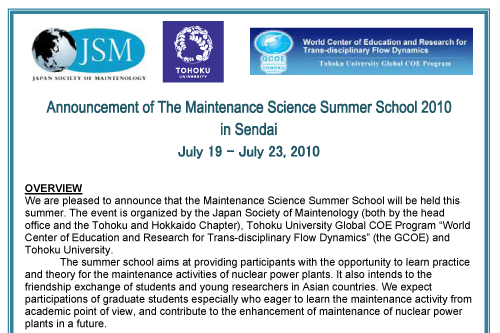Institute of Fluid Science, Tohoku University, Miyagi, Japan
Noritaka Yusa,
Department of Quantum Science and Energy Engineering,
Graduate School of Engineering, Tohoku University, Miyagi, Japan
This article is a report on the "Maintenance Science Summer School 2010" held at Tohoku University during July 19–25, 2010, and organized by the Japan Society of Maintenology (JSM), Tohoku University and the Tohoku University Global COE program "World Center of Education and Research for Trans-Disciplinary Flow Dynamics".
The aim of the summer school program is to provide opportunities to study "maintenance science" to young researchers from graduate schools in all Asian countries, but particularly in Japan, China, and Korea. There were 15 participants: one PhD candidate from the School of Aerospace, Xi'an Jiaotong University, China; one PhD candidate from the Aeronautical Science Key Laboratory for Smart Material and Structures, Nanjing University of Aeronautics and Astronautics, China; three PhD candidates from the School of Aerospace, Tsinghua University, China; one PhD candidate from the School of Nuclear Science and Engineering, North China Electric Power University, China; one PhD candidate from the School of Mechanical Engineering, Sungkyunkwan University, Korea; one master’s degree student from the Graduate School of System Informatics, Kobe University, Japan; one PhD candidate from the Department of Nuclear Engineering and Management, The University of Tokyo, Japan; one PhD candidate from the Division of Materials and Manufacturing Science, Osaka University, Japan; one researcher from the Fracture and Reliability Research Institute, Tohoku University, Japan; one PhD candidate and one researcher from the Department of Quantum Science and Energy Engineering, Tohoku University, Japan; and one master’s degree student and one PhD candidate from the Institute of Fluid Science, Tohoku University, Japan. About half of the participants were from universities outside Japan and the other half were from Japanese universities, but four of the eight participants from Japanese universities were international students from China. The organizers were pleased with the participation level.
The invitations for the summer school program were announced thorough the JSM mailing list, JSM website, and direct emails to related laboratories. Figure 1 shows the summer school announcement, which also describes the overview and purpose of the program.
Fig. 1 Summer school announcement
Figure 2 shows the schedule of the summer school program. The summer school consisted of lectures, student presentations, a visit to the Onagawa nuclear power plant, and a laboratory tour/visit. The official language of the summer school was English; all activities held during the summer school were carried out in English. Most of the participants did not have experience exchanging ideas with others in English, and thus the summer school provided them with a good experience for future international exchange.
| 9:00-12:00 | 13:00-15:00 | 15:30-17:30 | 18:30- | |||
|---|---|---|---|---|---|---|
| Sum. 18th |
Welcome Reception | |||||
| Mon. 19th |
Opening Ceremony |
Lecture 1 (Prof. Miyano) Lecture 2 (Prof. Ogawa) |
Student Presentation 1 | Japan Culture (Japanese Drum) | Start of Summer School |
|
| Tue. 20th |
Lecture 3 (Prof. Peng) Lecture 4 (Mr. Otokita) |
Tohoku University Tour | Student Presentation 2 | |||
| Wed. 21st |
Onagawa Nuclear Power Plant Station Visit | |||||
| Thu. 22nd |
Lecture 5 (Prof. Uchimoto) Lecture 6 (Dr. Inada) |
Lab. Tour | Student Presentation 3 | |||
| Fri. 23rd |
Lecture 7 (Prof. Aoki) | Lab. Visit | Wrap-up and Closing Ceremony | Farewell Party | End of Summer School |
|
| Student Presentation 4 | ||||||
Fig. 2 Summer school program schedule
The titles of the lectures and names of the lecturers were:
- -From Design for Performance to Design for Maintenance (Prof. Hiroshi Miyano, Hosei University)
- -Application of a Cold-spray Technique in Repair of Degraded and Damaged Parts of Materials (Prof. Kazuhiro Ogawa, Tohoku University)
- -Stress Corrosion Cracking of Austenitic Alloys in High Temperature Water (Prof. Qunjia Peng, Tohoku University)
- -Outline of the Maintenance of the Onagawa NPP (Mr. Satoru Otokita, Tohoku Electric Power Co.)
- -Pipe Wall Thinning Management and Evaluation Methods (Dr. Fumio Inada, Central Research Institute of Electric Power Industry)
- -Nondestructive Testing for Nuclear Power Plants (Prof. Tetsuya Uchimoto, Tohoku University)
- -Maintenance in Japanese Nuclear Power Plants (Prof. Takayuki Aoki, Tohoku University)
The lectures were organized so that they provided an overview of the maintenance activities of nuclear power plants, and covered the four essential components of this maintenance, namely, materials, inspection, evaluation, and repair. Some photographs taken during the lectures are presented in Figure 3.
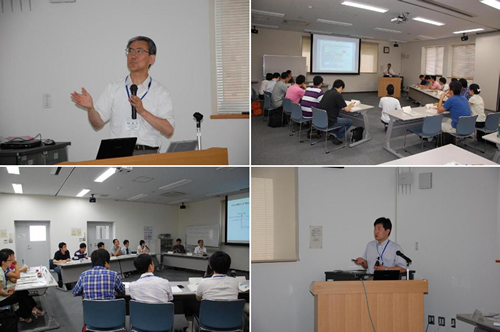
Fig. 3 Summer school lectures
In the student presentation sessions, each student was required to present his/her research to the others. Each was allotted 30 minutes for presentation and discussion. This was quite long, the goal being to make the sessions more like a laboratory discussion rather than a formal conference presentation. The participants were also required to chair the sessions in order to encourage self-motivation. This was challenging for the participants at the beginning, but the students improved significantly, and each day the discussion became more active. In order to promote interaction among the participants, the organizers assigned homework in which each participant evaluated the others’ presentations. The homework included suggestions for the improvement of presentation skills and possible future studies. The content of all the homework submitted was summarized by the organizers, anonymized, and given to each of the participants. The organizers expect that this experience will be beneficial in the future for the participants as they take on roles of evaluator and/or evaluatee.

Fig. 4 Student presentation sessions
The summer school organized a tour to the Onagawa Nuclear Power Plant on July 21st. The tour included a presentation of an overview of the plant (given by Tohoku Electric Power Co.), a visit to the reactor and other buildings, observation of actual pipe corrosion, and a Q&A session. Most participants expressed regret that the plant visit only lasted two hours, as the tour left Sendai for the plant in the morning and returned in the evening of the same day. The students found the visit impressive, especially for those participants (approximately half) who had never visited a nuclear power plant before. Some of the photographs taken during the tour are presented in Figure 5.
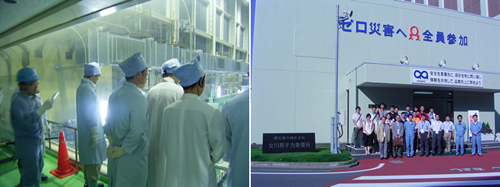
Fig. 5 Visiting the Onagawa Nuclear Power Plant, Tohoku Electric Power Co.
The laboratory tours and visits were carried out with the help of the Tohoku University faculty members, Prof. Shoji, Assoc. Prof. Ogawa, and Prof. Takagi. All the participants briefly visited the three laboratories on July 22nd. Then, the participants were separated into three groups and each group visited one of the laboratories a second time for practical training sessions and a detailed discussion about the research activities conducted there.
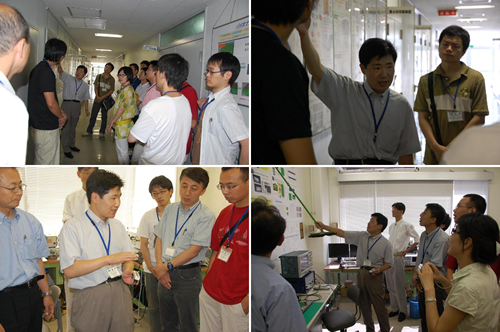
Fig. 6 Laboratory tour and laboratory visit
In addition to these educational lessons, the summer school program included a welcome party, a Kamotsunamura drum performance, a visit to the Tohoku University Archives, and a farewell party. The organizers sincerely hope that friendships and correspondence among the participants will continue after the conclusion of the summer school program.
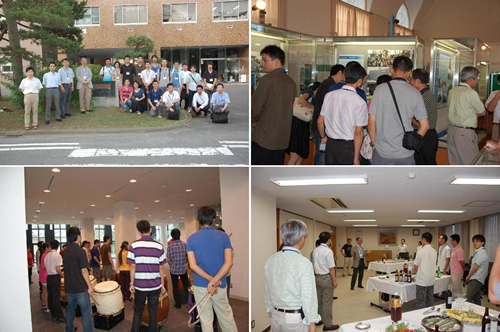
Fig. 7 Tohoku University Archives visit, Kamotsunamura drum performance, and farewell party
Figure 8 summarizes part of the results of a questionnaire given to the participants at the end of the summer school program. The results indicate that the participants found the program very satisfying, and most comments were favorable. It is therefore reasonable to conclude that the first summer school program was quite successful.

(a) Opinions of the summer school program
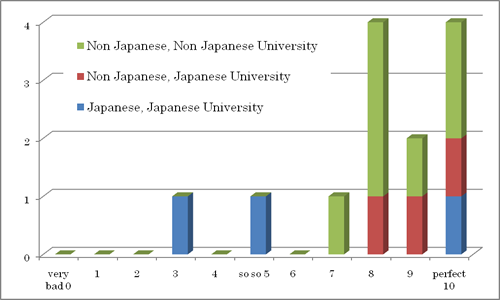
(b) Opinions of the summer school schedule
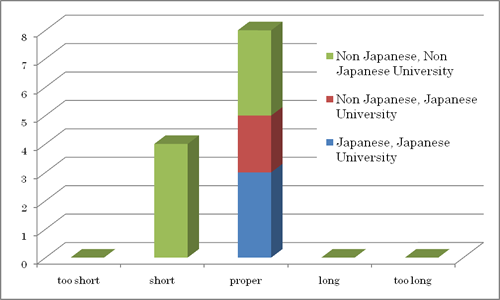
(c) Opinions on the appropriateness of the length of the summer school program
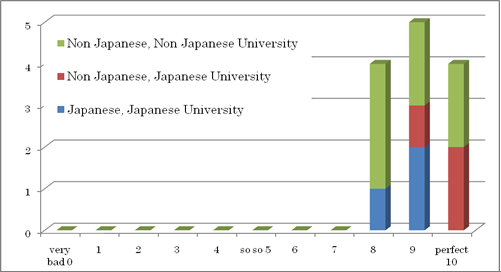
(d) Opinions of the quality of the summer school program
However, experiences obtained through the summer school revealed that there were several problem areas that could be improved for the summer school program organized by JSM.
First, the organizers did not discuss the background of the participants in much detail in advance of the summer school, and consequently some of the participants did not have a sufficient background in nuclear engineering. As mentioned above, most of the participants were not from nuclear engineering departments. Table 1 shows the portion of the participants who understood the listed abbreviations before attending the summer school. This information was obtained through a questionnaire. The table clearly shows that in most cases participants did not have sufficient background knowledge to discuss the maintenance of nuclear power plants (two of the participants did not even know what PWR and BWR stand for). It was necessary to hold lectures providing the overview on the structure and aging of nuclear power plants at the beginning of the summer school program. The table also shows the results of the same questionnaire given to seven graduate students in the Department of Quantum Science and Energy Engineering, Tohoku University. Although the research activities of the laboratories that all the Tohoku University students belonged to were within the scope of maintenance of nuclear power plants, it is quite likely that their knowledge is limited to research activities conducted in the laboratory and does not cover the structure and aging of nuclear power plants in general.
Table 1 Abbreviations related to nuclear power plants and proportion of students who knew the abbreviated term
| Summer school participants | Graduate students in Tohoku University | |
| BWR, PWR | 11/13 | 7/7 |
| ABWR | 7/13 | 7/7 |
| CANDU | 3/13 | 5/7 |
| AP-1000 | 8/13 | 0/7 |
| RPV | 3/13 | 1/7 |
| PWSCC | 5/13 | 1/7 |
| TBM, CBM | 2/13 | 1/7 |
| LDI | 5/13 | 6/7 |
| FAC | 6/13 | 7/7 |
| CRDM | 2/13 | 0/7 |
| PLR | 1/13 | 0/7 |
| Alloy 600 | 6/13 | 2/7 |
| PDCA | 2/13 | 2/7 |
In addition, it is quite likely that the summer school did not present the structure and overview of "maintenance science" clearly enough to the participants. Although the questionnaire suggested that each individual lecture was found to be satisfactory by the participants, the relationship among the content of the lectures may not have been clear enough for them. More discussion is needed on what should be taught to participants during the summer school program, and on what comprises "maintenance science."
Educating younger generations is one of the most important missions of the JSM. However, this cannot be achieved solely by university faculties, because understanding the structure of the maintenance activities of nuclear power plants requires a deeper knowledge of various matters such as reactor physics, structure, degradation mechanisms, risk-based analysis, practice, historical background, and even regulation. It is very important for JSM members working not only at universities but also those working in industry and as plant owners, to discuss what kind of knowledge and experience young students, who will later conduct the maintenance activities of nuclear power plants, should be equipped with during their studies. The content of suitable textbooks should be discussed as well.
Since this was the first summer school program organized by JSM, there was not much time to prepare properly. There are various issues concerning the summer school that require further reflection and response. We propose holding a second summer school program in Japan in 2011 that will clearly define "maintenance science" and clarify the future direction of such summer schools.
Finally, we would like to express our sincere gratitude to the lecturers, participants, the supervisors of the participants, the Tohoku Electric Power Co. Ltd., and all those who contributed to the success of the summer school. And special thanks go to Professor Naoto Wada, Ms. Yukie Yamakawa, and Ms. Nami Tohara for their dedicated efforts.






